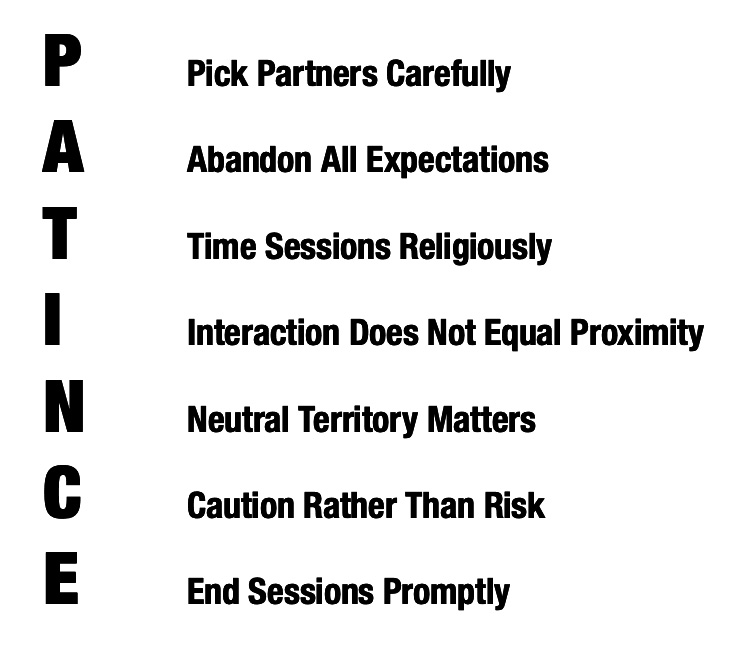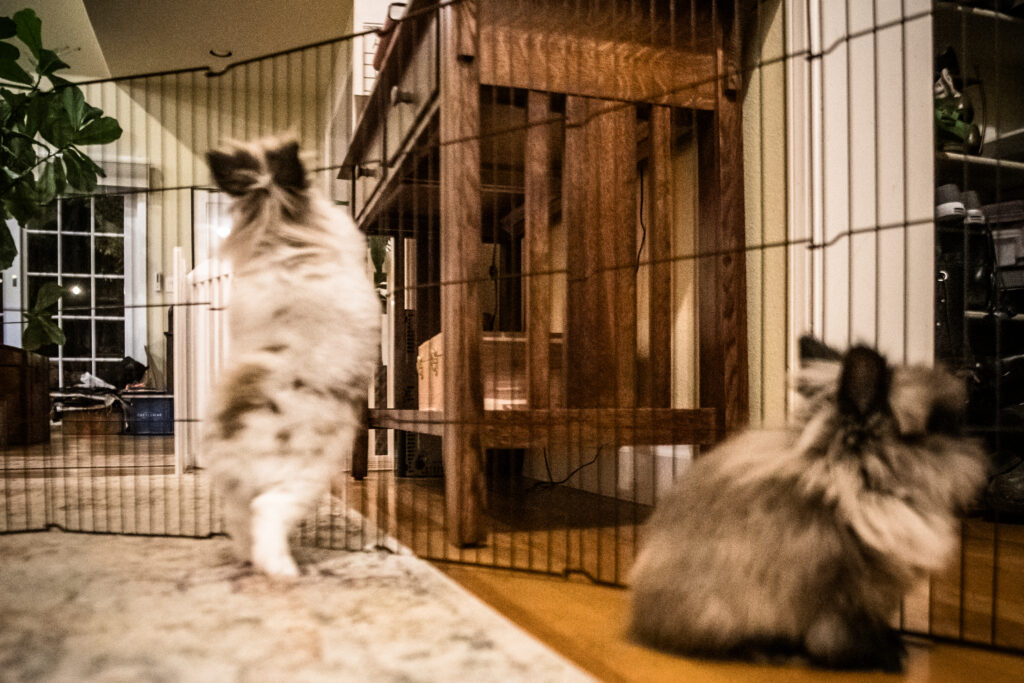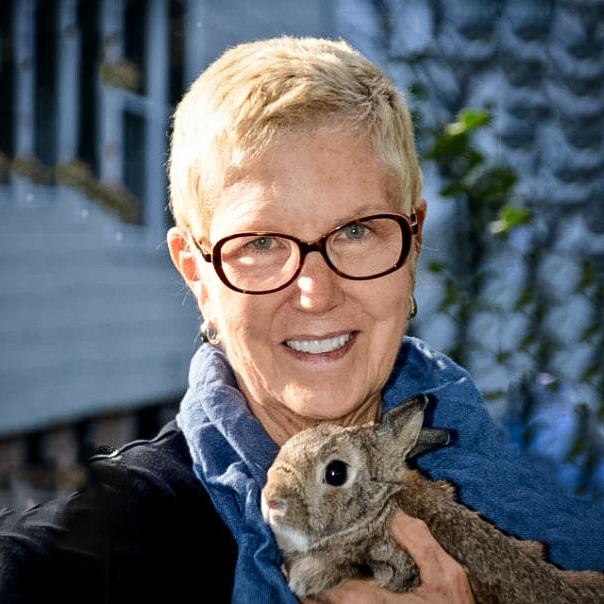Patience is the magic word when it comes to bunny bonding.

PICK potential partner rabbits carefully. There is tremendous variability in how rabbits get along with each other upon first meeting. A few seem to genuinely like each other and seek out each other’s company; many seem to “squabble” and bicker until it becomes clear that the other rabbit is not a threat; and a few seem to want to demolish each other. Many people, out of ignorance, make the mistake of acquiring baby rabbits who get along just fine – at first, because they are juveniles, and subsequently because male/female pairs want to breed. Once the rabbits reach sexual maturity and are spayed/neutered, however, things may change. The smoothest bondings are typically those in which the rabbits have meaningful input in the process. The rabbit caretaker’s choice of a partner rabbit (based on size, breed, color, etc.) may differ dramatically from the rabbit’s own choice, and attempts to force a rabbit to accept another rabbit may end sadly.
In the early nineties, when I joined the first rabbit Internet listservs, I was struck by how many humans seemed to be trying to “threaten” rabbits into a bond. I remember one rescuer in particular who claimed to be able to bond any pair of rabbits, regardless of whether they “liked” each other. This was very impressive to me, until I learned how many bondings created this way subsequently fell apart. Pick the rabbit who gets along best with your own rabbit; you will have a much easier time, and you will increase the chances for a solid, long-term bond.
ABANDON all expectations. Owner expectations of how a bonding “should” proceed are almost always different from how it actually does proceed, and attempting to force rabbits to live up to expectations almost always leads to disappointment. Some years ago, an owner complained that her rabbits “just weren’t bonding,” although they had lived together peacefully for many months. She was not aware that some bonds seem to be “love” bonds, with constant mutual grooming, while others may seem more “platonic.” Either type of bond is just fine; let the rabbits decide the degree of closeness that works for them, and accept their decision without pressuring them toward further “closeness.” That said, when rabbits are housed in side-by-side cages or puppy exercise pens (as they are in many rescue situations, because those of us who foster often have little choice), the initial arousal caused by being so close to an unfamiliar rabbit often gradually gives way to indifference toward, or even acceptance of, the presence of another rabbit. I shared this information with our early volunteers, and we began to use this setup as a first step toward producing a peaceful bond. Rabbits who are given the opportunity to live peacefully near another rabbit, and who can see, hear and smell the other rabbit, are subsequently much easier to introduce outside their cages.
A note about “living peacefully”: pens or cages should be placed side-by-side with enough space between them (usually around 3 inches) so that the rabbits cannot press their noses through the spaces between the bars to touch (or bite!) each other. If necessary, place an object (such as a water bottle on its side) between the pens, to prevent the rabbits from pushing the pens closer. If one rabbit is getting out-of-cage exercise time, it should be in an area well away from the other rabbit’s pen. These two considerations are key to keeping the peace.
Occasionally, rabbits will bond on their own without any special efforts on the part of their humans. In one instance, a fosterer housed two unrelated female rabbits in an extra bedroom for almost a year, and reported that she was getting the feeling that these rabbits “liked” each other, although they had never been introduced. She was right: we introduced those rabbits and they bonded immediately. Was this “love at first sight”? Or was it the long-term effect of living peacefully in the same room? Hard to tell, and we may never know. But it certainly was not anyone’s expectation!
TIME all bonding sessions religiously. In their eagerness to get the job done, many rabbit caretakers unknowingly slow down the bonding process by pushing for too much, too soon. Resist the temptation to extend bonding sessions.
The best bonding sessions are short, and always end on a successful note. Set a timer for one minute at first, and separate the rabbits after that time, no matter what they are doing. Several very short, very peaceful bonding sessions per day will go much farther in creating a solid bond than longer sessions where the rabbits become hostile toward one another and need to be separated. After several, peaceful, one-minute sessions, increase the time to 90 seconds, and then two minutes. As you continue with bonding sessions, you will develop a good sense of how long the rabbits can be together successfully. As long as you do not exceed this time, you will not lose ground.
It is much easier to be patient if you remind yourself that a single incident of significant rabbit-to-rabbit aggression caused by owner impatience can set the whole process back days or weeks…or in some instances, months.
INTERACTION does not equal physical proximity. Interaction is anything the rabbits do while in the same space with another rabbit. Physical proximity is not the sole, or even the most important, criterion, for “interaction.” In other words, rabbits can be interacting regardless of whether they are physically close to each other. A rabbit who systematically moves to increase distance from another rabbit is interacting in a very clear way that should be respected.
Think of the New York City subway system: if, say, a woman enters a subway car at night where there is only one other rider – a man, sitting by himself, the woman is likely to choose a seat on the other end of the car from the man. Her choosing that distance is not a failure to interact; it is an interaction.
In nature, rabbits have virtually unlimited space to use as part of their communication when they meet other rabbits, but when we introduce them in our homes, the space we offer them is typically much more limited, so their ability to communicate using space (creating distance) may be impaired. Nevertheless, when bonding rabbits in a limited space, many rabbit caretakers worry that the rabbits are “not interacting” when they choose to stay distant from one another, and these caretakers repeatedly move the rabbits closer in a misguided effort to “get them to bond.”
EVALUATE interactions frequently during each session. Do not let the rabbits’ apparently compatible behavior at the outset lull you into complacency. Things can change quickly, and a session that started out peacefully can turn sour with one backwards hump or head-to-tail chase! If you are not thoroughly familiar with normal rabbit behavior, ask someone who is to help you evaluate what you are observing.
NEUTRAL territory matters! Introducing rabbits in “neutral territory” can make a big difference in their ability to get along. If either rabbit “owns” the territory, the bonding process can be significantly more difficult, since the “owner-rabbit” will almost always want to remove the other rabbit from his/her turf, by whatever means possible. If your own rabbit is free-range and “owns” the whole house, consider doing the introduction and bonding in the basement or in a friend’s home. In apartment buildings that have carpeted hallways and friendly neighbors, it is often possible to use a public hallway for short periods of time. The bottom line: doing your best to find a space that is not “owned” by either rabbit will make the bonding process easier on both you and the rabbits.
CAUTION rather than risk! Serious, but completely avoidable injuries have occurred during the bonding process simply because the humans involved took unnecessary risks. Have a friend or assistant help you with the bonding, if possible, and intervene swiftly and skillfully to prevent any sort of aggressive or dangerous behavior (e.g., lunging, ears laid back, head-to-tail circular chasing, jumping directly over the other rabbit, backwards mounting). Wearing a pair of soft-soled shoes or potholder mitts on your hands will allow you to intervene safely and will prevent injury both to you and to the rabbits. Simply plunge your protected hands into any sudden fray or unexpected confrontation between the rabbits, in a manner that allows them to redirect their aggression onto your hands. If necessary, you can firmly and snugly “straddle” one rabbit’s body with your protected hands, while a friend or assistant removes the other rabbit, or blocks off his access to your rabbit.
If you are fairly new to rabbits, and are not sure what a particular behavioral display means, or if you even think one rabbit is becoming agitated or exhibiting aggressive behavior toward the other, err on the side of caution and separate the rabbits. If you wonder if the bonding session has gone on too long, err on the side of caution and terminate the session. Exercising caution may mean the bonding process will take a bit longer, but the process will be safer and more peaceful for both you and the rabbits.
END encounters promptly, and end on a successful note; do not be tempted to extend bonding sessions early on, simply because you feel that “the rabbits are doing so well!” Bondings are almost always much easier and more peaceful when they are short and frequent. Failure to end a session after a short time can lead to escalating stress, arousal and aggression on the part of the rabbits.
©Copyright Mary Cotter. All Rights Reserved. Republished with the permission of the author.
Reprinted from the NYC Metro Rabbit News, April 2014.

